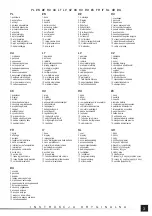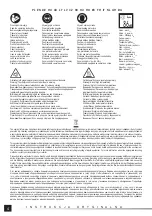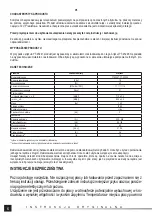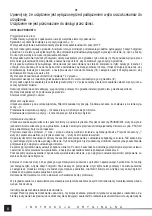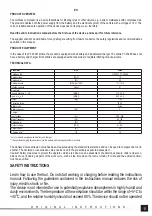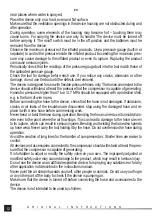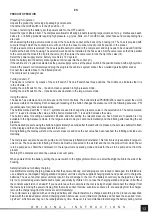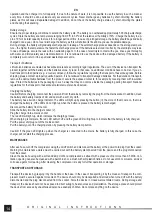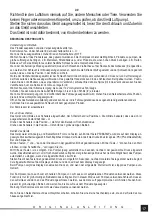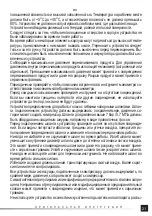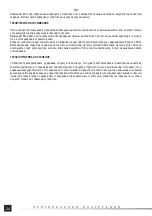
14
EN
O R I G I N A L I N S T R U C T I O N S
operation and then charge it to full capacity. If, due to the nature of work, it is not possible to use the battery in such a manner
every time, it should be done at least every several work cycles. Never discharge any batteries by short-circuiting the battery
plates, as this will cause irreparable damage! In addition, do not check the battery charge status, by short-circuiting the plates
and checking their sparking.
Battery storage
Ensure the proper storage conditions to extend the battery’s life. The battery can withstand approximately 500 charge-discharge
cycles. Store the battery at a temperature ranging from 0ºC to 30ºC at the relative air humidity of 50%. Charge the battery to ap-
prox. 70% of its total capacity to store it for a longer period of time. In case of prolonged storage, the battery should be periodically
charged once a year. Do not over-discharge the battery as this will shorten its life and may cause irreparable damage.
During storage, the battery will gradually discharge due to leakage. The self-discharge process depends on the storage tempera-
ture – the higher the temperature, the faster the discharge process. If the batteries are stored incorrectly, the electrolyte may leak.
In case of leakage, secure the leak with a neutralising agent. In the case of electrolyte contact with eyes, rinse eyes thoroughly
with water, and immediately seek medical attention. It is not allowed to use the device with a damaged battery. If the battery is
completely worn, return it to a specialist waste disposal centre.
Transport of batteries
Lithium-ion batteries are treated as hazardous materials, according to legal regulations. The user of the device can transport the
product together with the battery and the batteries alone, by land. In that case, no additional conditions have to be met. If you en-
trust transport to third parties (e.g. a courier company), follow the regulations regarding the transport of hazardous goods. Before
shipping, please contact a properly quali
fi
ed person. It is not allowed to transport damaged batteries. For the duration of transport,
remove the demountable batteries from the product, secure the exposed contacts, for example by covering them with insulation
tape. Protect the batteries in the packaging in such a way that they do not move inside the packaging during transport. National
regulations for the transport of hazardous materials must also be observed.
Charging the battery
Caution! Before charging, disconnect the power unit from the mains by removing the plug from the mains socket. In addition, clean
the battery and battery clamps of dirt and dust with a soft, dry cloth.
The battery has a built-in charge indicator. The LEDs will light up by pressing the button (II), the more of them come on, the more
charged the battery is. If the LEDs do not light up when the button is pressed, the battery is discharged.
Disconnect the battery from the tool.
Slide the battery into the charger socket (V).
Plug the charger into a mains socket.
The red LED will light up, which indicates the charging process.
When charging is complete, the red LED will turn o
ff
and the green LED will light up to indicate that the battery is fully charged.
Pull the power unit plug out of the mains socket.
Pull the battery out of the charging station by pressing the battery clamp button.
Caution! If the green LED lights up when the charger is connected to the mains, the battery is fully charged. In this case, the
charger will not start the charging process.
MAINTENANCE
After each use, turn o
ff
the compressor using the on/o
ff
switch and disconnect the battery or the power cord plug from the socket.
Warning! All maintenance works must be carried out with the battery disconnected from the device and the plug disconnected
from the socket.
Clean the device housing with a soft and damp cloth or a compressed air stream with a pressure of not more than 0.3 MPa. Ven-
tilation opening can also be cleaned with a paint brush or a brush with soft plastic bristles. Do not use alcohol, solvents, acids or
corrosive agents for cleaning. After cleaning, the compressor is ready for further operation or storage.
TRANSPORT AND STORAGE
Transport the device by grasping it by the handle or the base. In the case of transporting it by the means of transport, the com-
pressor must be secured against movement. The device should only be transported and stored when turned o
ff
with the battery
disconnected and the plug disconnected from the socket. Store the device in closed well-ventilated rooms. During storage and
transport, the device should not be exposed to direct sunlight, heat sources and precipitation. The storage place should protect
the device from access by unauthorised persons, especially children. Do not place anything on the device.
Содержание YT-23247
Страница 21: ...21 RU 5O C 40O C 80 7 0 7...
Страница 22: ...22 RU O OFF II III III 12 IV 12 O I II PSI BAR kPa PSI 3 0...
Страница 23: ...23 RU Li Ion 500 0 30 50 70 II V...
Страница 24: ...24 RU 0 3...
Страница 26: ...26 UA 5 O C 40 O C 80 7 0 7...
Страница 27: ...27 UA O OFF II III III 12 IV 12 I II PSI BAR kPa PSI 3 0...
Страница 28: ...28 UA 500 0 30 50 70 II V...
Страница 29: ...29 UA 0 3...
Страница 74: ...74 GR 5 O C 40 O C 80 7 bar 0 7 MPa...
Страница 75: ...75 GR OFF II III III 12 V IV 12 V O II PSI BAR kPa PSI bars kilopascals 3 0...
Страница 76: ...76 GR Li Ion 500 0 30 50 70 LED LED V LED LED LED LED...
Страница 77: ...77 GR 0 3 Mpa...
Страница 79: ...79 BG 5 O C 40 O C 80 7 bar 0 7 MPa...
Страница 80: ...80 BG OFF II III III 12 V IV 12 V I II PSI BAR kPa PSI 3 0...
Страница 81: ...81 BG Li Ion 500 0 30 50 70 II V...
Страница 82: ...82 BG 0 3 MPa...



